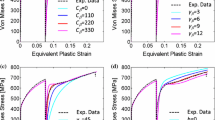Abstract
In a ductile material, the total work of fracture is not a material constant and linear fracture mechanics is inappropriate. The work performed in the end region at the tip of a crack, where the fracture process takes place, is considered the essential work of fracture, and a constant for a particular sheet thickness. It is shown that this essential work can be estimated from deep edge notched tension specimens by extrapolating the straight line relationship between the work of fracture and ligament length to zero ligament length.
Résumé
Dans un matériau ductile, le travail de rupture n'est pas constant quel que soit le matériau, et la théorie linéaire élastique de la rupture n'est pas appropriée.
Le travail effectué dans la région la plus en avant de l'extrémité de la fissure, ou le processus de rupture prend place, est considéré comme le travail essentiel de rupture et est une constante pour une épaisseur particulière de tôle. On montre que ce travail essentiel peut être estimé à partir d'éprouvettes encochées latéralement par des entailles profondes, en extrapolant la relation linéaire existant entre le travail de rupture et la longueur du ligament en direction d'une longueur égale à zéro.
Similar content being viewed by others
References
K. B. Broberg, International Journal of Fracture Mechanics, 4 (1968) 11–19.
K. B. Broberg, Journal of the Mechanics and Physics of Solids, 19 (1971) 407–418.
K. B. Broberg, Journal of the Mechanics and Physics of Solids, 23 (1975) 215–237.
E. Orowan, Fundamentals of Brittle Behaviour in Metals, Fatigue and Fracture of Metals, Wiley, New York (1950).
G. R. Irwin, Journal of Applied Mechanics, 24 (1957) 361–364.
A. A. Wells, British Welding Journal, 10 (1963) 563.
D. S. Dugdale,Journal of the Mechanics and Physics of Solids (1960) 100–104.
A. S. Tetelman and A. J. McEvily, Fracture of Structural Materials, Wiley, New York (1967).
G. T. Hahn and A. R. Rosenfield, Acta Metallurgica, 13 (1965) 293–306.
G. R. Irwin and J. E. Srawley,Material Prufung (1962) 1.
R. Hill, Journal of the Mechanics and Physics of Solids, 4 (1952) 19–30.
J. K. Reddel,Plane stress ductile fracture, M.Eng.Sc. Thesis (1975).
J. M. Krafft, A. M. Sullivan and R. W. Boyle,Proceedings of the Crack Propagation Symposium, Cranfield (1961) 8–28.
J. E. Flood and R. M. Ganison, Journal of the Iron and Steel Institute (1973) 369–373.
Author information
Authors and Affiliations
Rights and permissions
About this article
Cite this article
Cotterell, B., Reddel, J.K. The essential work of plane stress ductile fracture. Int J Fract 13, 267–277 (1977). https://doi.org/10.1007/BF00040143
Received:
Revised:
Issue Date:
DOI: https://doi.org/10.1007/BF00040143




